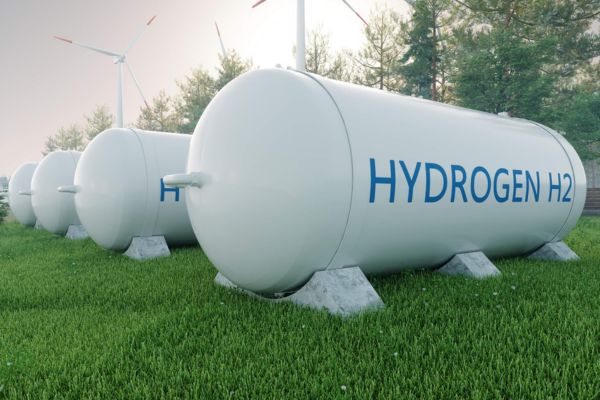The global hydrogen storage market is experiencing robust growth and transformation, with a projected market size of USD 1,171.20 Million by 2034, up from USD 606.62 Million in 2024. This remarkable growth highlights the increasing importance of hydrogen as a clean and sustainable energy source, driving demand for efficient and safe storage solutions. With a Compound Annual Growth Rate (CAGR) of 6.8% from 2023 to 2034, the hydrogen storage industry is poised to play a crucial role in the broader transition to a low-carbon future.

The Growing Demand for Hydrogen Storage Solutions
Hydrogen, as a zero-emission energy carrier, has gained significant attention in recent years, particularly in sectors such as transportation, power generation, and industrial applications. However, the challenge of storing hydrogen safely and efficiently remains a key hurdle. Hydrogen, being the lightest element, has a very low energy density in its gaseous form, necessitating advanced storage solutions for effective utilization.
This has led to the rapid evolution of hydrogen storage technologies, which can be broadly categorized into three primary methods:
- Compressed Hydrogen Storage
This is the most common method, involving storing hydrogen gas at high pressure in metal cylinders or composite tanks. It is typically used in hydrogen-powered vehicles and portable applications. Due to the high energy demands for compression, significant advances in lightweight materials and tank designs are helping make this storage method more energy-efficient. - Liquefied Hydrogen Storage
Hydrogen can also be stored in its liquid form at cryogenic temperatures. Liquefied hydrogen provides a higher energy density than gaseous hydrogen, making it ideal for large-scale applications, including fuel cells for commercial transportation and aviation. However, the need for specialized storage tanks and energy-intensive cryogenic systems remains a challenge. - Solid-State Hydrogen Storage
Solid-state storage systems, including metal hydrides and chemical hydrogen storage, offer promising solutions for safe and efficient storage. These systems absorb and release hydrogen through chemical reactions, providing a more compact and safer alternative compared to traditional methods. Research and development in this area are focused on improving the energy density and cost-efficiency of these materials.
Unlocking the Forces Shaping Market Trends
- Clean Energy Shift: Hydrogen is crucial for decarbonizing industries like transportation and power generation.
- Government Support: Global policies and incentives are speeding up hydrogen adoption.
- Technological Advancements: Improvements in storage technologies are making hydrogen storage more efficient and affordable.
Regional Insights
The hydrogen storage market is expanding across various regions, with significant growth prospects in the following areas:
- North America
North America, especially the U.S. and Canada, is expected to be a major market for hydrogen storage. The region is making substantial investments in clean energy infrastructure, with hydrogen playing a crucial role in meeting carbon reduction targets. Government initiatives like the U.S. Department of Energy’s Hydrogen Program are pushing the market forward. - Europe
Europe remains at the forefront of hydrogen development, with the European Commission’s green hydrogen strategy, which aims to make hydrogen an integral part of the EU’s energy mix by 2030. Germany, France, and the Netherlands are leading the charge, with initiatives to build hydrogen refueling stations, storage facilities, and develop cross-border hydrogen pipelines. - Asia-Pacific
Asia-Pacific, particularly Japan and South Korea, is embracing hydrogen as a strategic solution for energy security and sustainability. Japan’s Hydrogen Roadmap, which targets a hydrogen-based society by 2050, and South Korea’s initiatives to reduce carbon emissions are significant drivers for hydrogen storage technology adoption.
Challenges in Hydrogen Storage
Despite the promising growth trajectory, the hydrogen storage market faces several challenges:
- Cost of Storage Solutions
The cost of developing and implementing advanced storage technologies, especially for liquefied and solid-state hydrogen, remains a major obstacle. While technological advancements are helping, cost reduction is crucial for large-scale deployment. - Safety Concerns
Storing hydrogen, especially in large quantities, requires addressing safety concerns related to leakage, high-pressure systems, and cryogenic temperatures. Stringent safety standards and ongoing improvements in tank materials and infrastructure are essential to ensure public confidence. - Infrastructure Limitations
The lack of widespread hydrogen refueling stations and storage infrastructure in many regions remains a barrier to the adoption of hydrogen-powered vehicles and industrial applications. Governments and private companies are investing in building these networks, but scaling infrastructure will take time.
Conclusion: A Promising Future for Hydrogen Storage
The hydrogen storage market is set for significant growth over the next decade, driven by the increasing demand for hydrogen in the global energy transition, strong government backing, and ongoing technological advancements. With a projected market size of USD 1,171.20 Million by 2034, hydrogen storage will play a crucial role in achieving sustainability goals.
Although challenges related to cost, safety, and infrastructure persist, continued progress in storage technologies and supportive policies are expected to overcome these barriers.
Collaborative Efforts for a Hydrogen-Powered Future
As the market evolves, collaboration among industries, investors, and policymakers will be essential to ensure scalable, safe, and cost-effective hydrogen storage solutions—laying the foundation for a sustainable, hydrogen-powered future.

















